Out of the Depths: Sowerby’s Beaked Whales in the Wilmington Canyon
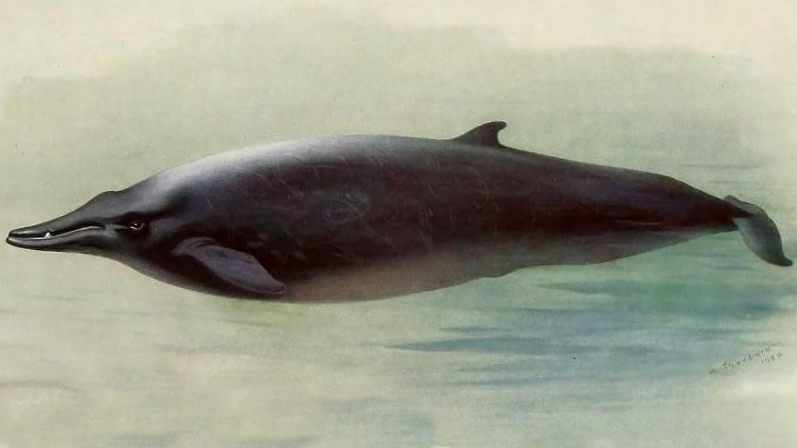
On June 18th 2023, the crew of the Cape May Whale Watch and Research Center and passengers prepared to head offshore in search of marine life on a 24 hour pelagic trip to the Wilmington Canyon. At 9pm, the American Star left the dock, and steamed through the darkness of the night to a location 92 miles offshore. The water temperature ranged from 64-68 degrees, and at the deepest point offshore, the water was about 7,500 feet deep. The longer duration of these trips gives the passengers and crew the advantage to see more marine life that cannot be sighted close to shore, including a wide range of dolphin species, sharks, and pelagic birds. In addition, the deep waters of the continental shelf and underwater canyons also provide a unique environment for some of the most peculiar of deep diving cetaceans, such as beaked whales.
On June 19th 2023 around 10am, the crew and passengers sighted and identified two small whales traveling together. These individuals were confirmed to be a mother and calf of the rarely seen Sowerby’s beaked whale (Mesoplodon bidens).

Sowerby’s beaked whale mother & calf as seen from American Star. Photo by Research Intern Mackenzie Briggs.
Beaked whales such as Sowerby’s belong to a group of highly unusual deep-diving toothed whales (family Ziphiidae). There are more than 20 species of beaked whale, and they are so-named due to their long dolphin-like “beak” or rostrum. They are usually small to moderate in size, with a sleek body shape smoothly tapered at the front and back like a spindle. Unlike many oceanic dolphin species, the dorsal fin on the back is small and set relatively far back on the body.

A Sowerby’s beaked whale at the surface. Note the long, sleek body and prominent dolphin-like beak. The dorsal fin is not seen in this photo, as it is far back on the body and submerged in this image. Photo credit: NOAA fisheries
While dolphins often have many teeth (as many as 80-90 for a bottlenose dolphin), most beaked whales have only 2-4 teeth, and they typically only erupt from the lower jaw in the males (Ellis and Mead, 2017). In some species such as Blainville’s beaked whale (Mesoplodon densirostris), the male’s teeth form impressive tusk-like structures which the males use to slash and rake one another (Ellis and Mead, 2017). Therefore, the teeth do not appear to be used for feeding, but instead are believed to play a role in aggressive behaviors between males fighting for the ability to breed with the females (Ellis and Mead, 2017). As a result of these submarine jousting matches, the bodies of male beaked whales are often laced with white scars resembling parallel lines (Ellis and Mead, 2017).
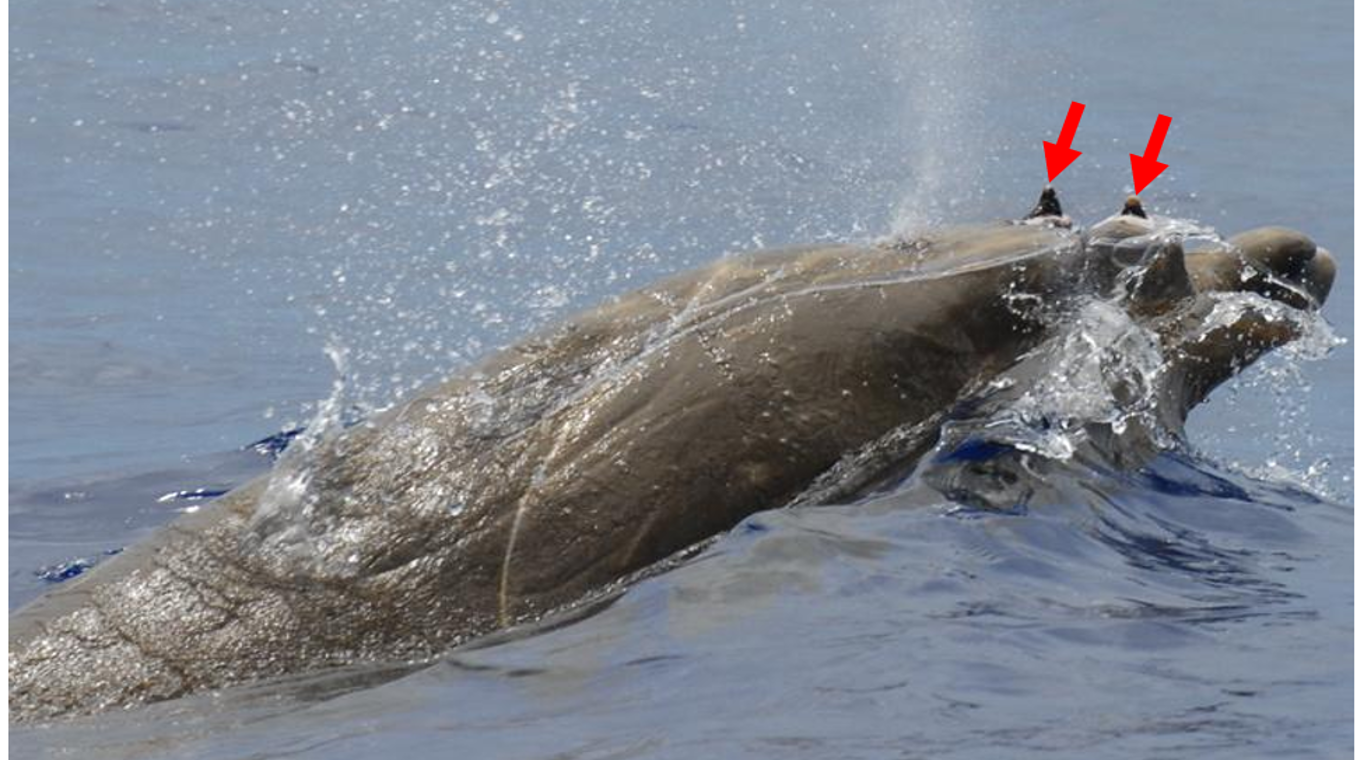
An adult male Blainville’s beaked whale (Mesoplodon densirostris) surfacing. The front of the animal is towards the right. Notice the two prominent tusk-like teeth erupting from the lower jaw (red arrows). Photo credit: NOAA Fisheries.

Photo credit: Michael Denk
Above is a left lateral (side) view of a skull from a young male Gervais’ beaked whale (Mesoplodon europaeus). This is a close relative of Sowerby’s beaked whale. The front of the skull is toward the left, and the back is toward the right. Note the narrow beak-like jaws, and the tusk-like tooth starting to erupt from the lower jaw closer to the tip (blue arrow).
Like dolphins and porpoises, all beaked whales have a fat-rich structure called the “melon” which forms the external forehead and helps to project sound into the water (McKenna et al. 2011; Denk et al. 2023). Hearing is one of the most important senses of whales, and beaked whales are no exception. The clicking sounds produced by beaked whales are used to sense the environment via echolocation, and may also play a role in communication.
The Sowerby’s beaked whale (Mesoplodon bidens) is found in the North Atlantic Ocean, and prefers deep-water environments near the continental shelf. Individuals of this species have a long beak and a small falcate dorsal fin near the middle of the back. These animals are a dark gray color above with a light gray belly, and when they surface to take a breath, the long gray beak is often what is seen first. Like other beaked whales, the male Sowerby’s beaked whale has two tusk-like teeth which erupt from the lower jaw. The males also can present with long gray or white scars and spots on their sides and back. These whales can be 14-21 feet and weigh 2,200-2,900 pounds.

A historic watercolor painting of a male Sowerby’s beaked whale from the book “British Mammals”, written by Archibald Thorburn and published in 1920. Notice the long rostrum, the small dorsal fin, and the two teeth erupting from the lower jaw.
Sowerby’s beaked whale may be found individually or in small close groups.
The average group size of these whales is about 3 to 10 whales ( NOAA Fisheries). However, due to the rarity of sightings, there is little known information about the overall population numbers of the Sowerby’s beaked whale. The lifespan of the Sowerby’s beaked whale is unknown because of their highly elusive nature (National Audubon Society Guide to Marine Mammals of the world). Sightings and photographs of these animals are considered rare, and therefore each observation represents a step forward in research and conservation. This species is an impressive diver, and can reach depths of 4,920 feet and can stay down for 28 minutes (National Audubon Society Guide to Marine Mammals of the world).
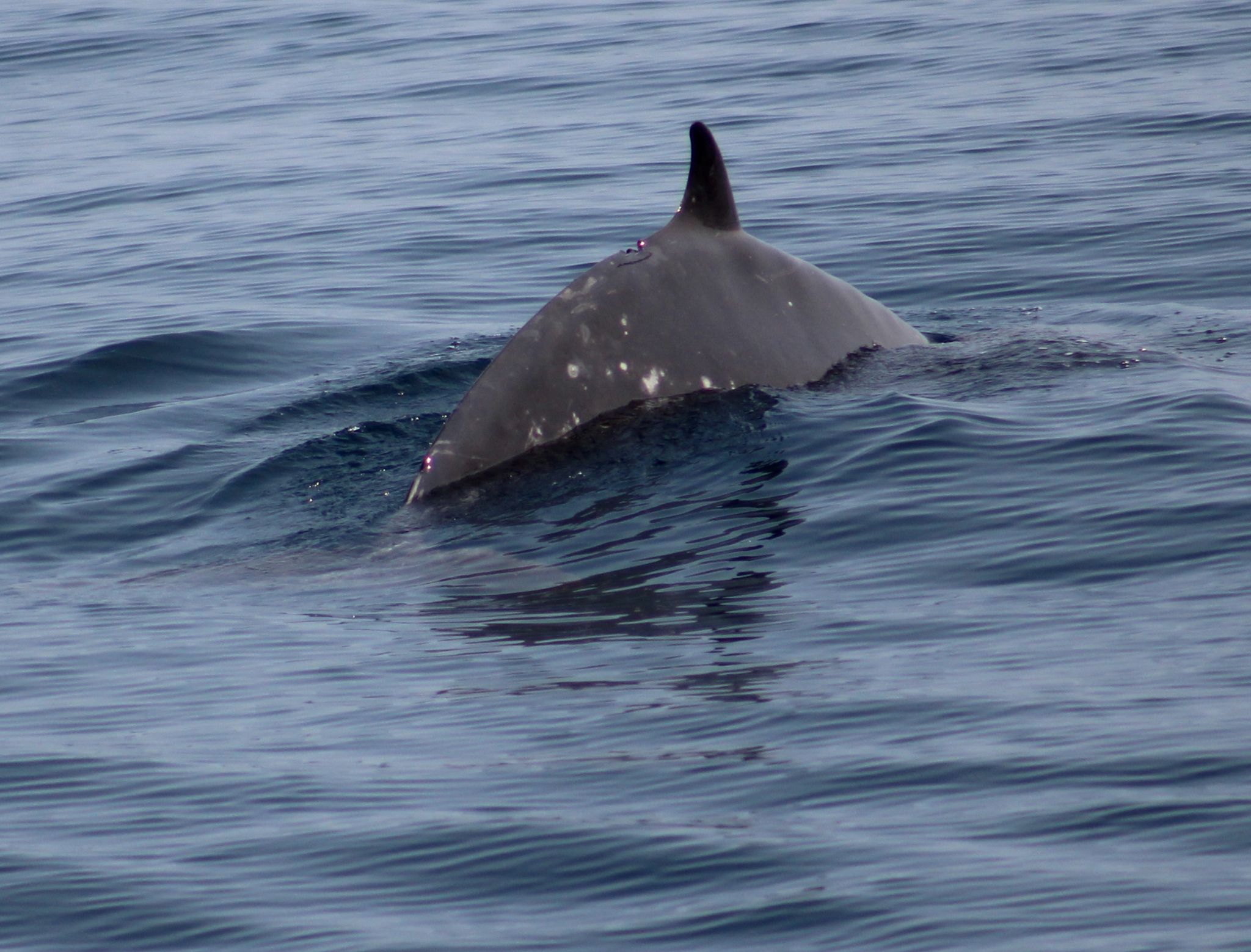
Sowerby’s beaked whale. Note the small dorsal fin. Photo by Research Intern Mackenzie Briggs
Beaked whales are renowned for their diving abilities. While Sowerby’s beaked whale is an impressive diver, Cuvier’s beaked whale (Ziphius cavirostris) is the current champion among all mammals for diving duration and depth. Individual Cuvier’s beaked whales have been documented to dive over 9,000 ft. deep (Schorr et al. 2014) and stay underwater for maximum durations of three hours and 42 minutes (Quick et al. 2020)! The reason for such extreme dives is food-related: beaked whales prey upon a wide range of small deep-sea squid and fish, which they capture via suction generated in the mouth (Ellis and Mead, 2017).

Cuvier’s beaked whale (Ziphius cavirostris), the current mammalian diving champion. Image credit: By NOAA United States. National Marine Fisheries Service – Cetaceans of the Channel Islands National Marine Sanctuary, Public Domain, https://commons.wikimedia.org/w/index.php?curid=45787516
To endure such deep dives and engage in these feeding behaviors, beaked whales exhibit many unusual anatomical and physiological characteristics. When a beaked whale dives for a long period underwater, they first exhale (spout), take a breath at the surface, and then submerge. During the dive, the whale is essentially holding its breath for hours in a world of cold temperatures and intense pressures. Therefore, conserving energy, heat, and oxygen in this hostile alien world is critical. Compared to shallow-diving marine mammals such as coastal bottlenose dolphins, the brain and digestive tract mass is relatively small in relation to body size, while bone and muscle mass is proportionally larger (Pabst et al. 2016). The brain and digestive tract are both “metabolically expensive”, and the brain is highly sensitive to lack of oxygen (Pabst et al. 2016). Muscle and bone, on the other hand, is “metabolically inexpensive,” and muscle tissue may even aid in storing oxygen (Pabst et al. 2016). Therefore, the larger ratio of muscle in comparison to the brain both increases relative onboard oxygen reservoir as well as minimizing risks to the all-important nervous system (Pabst et al. 2016).
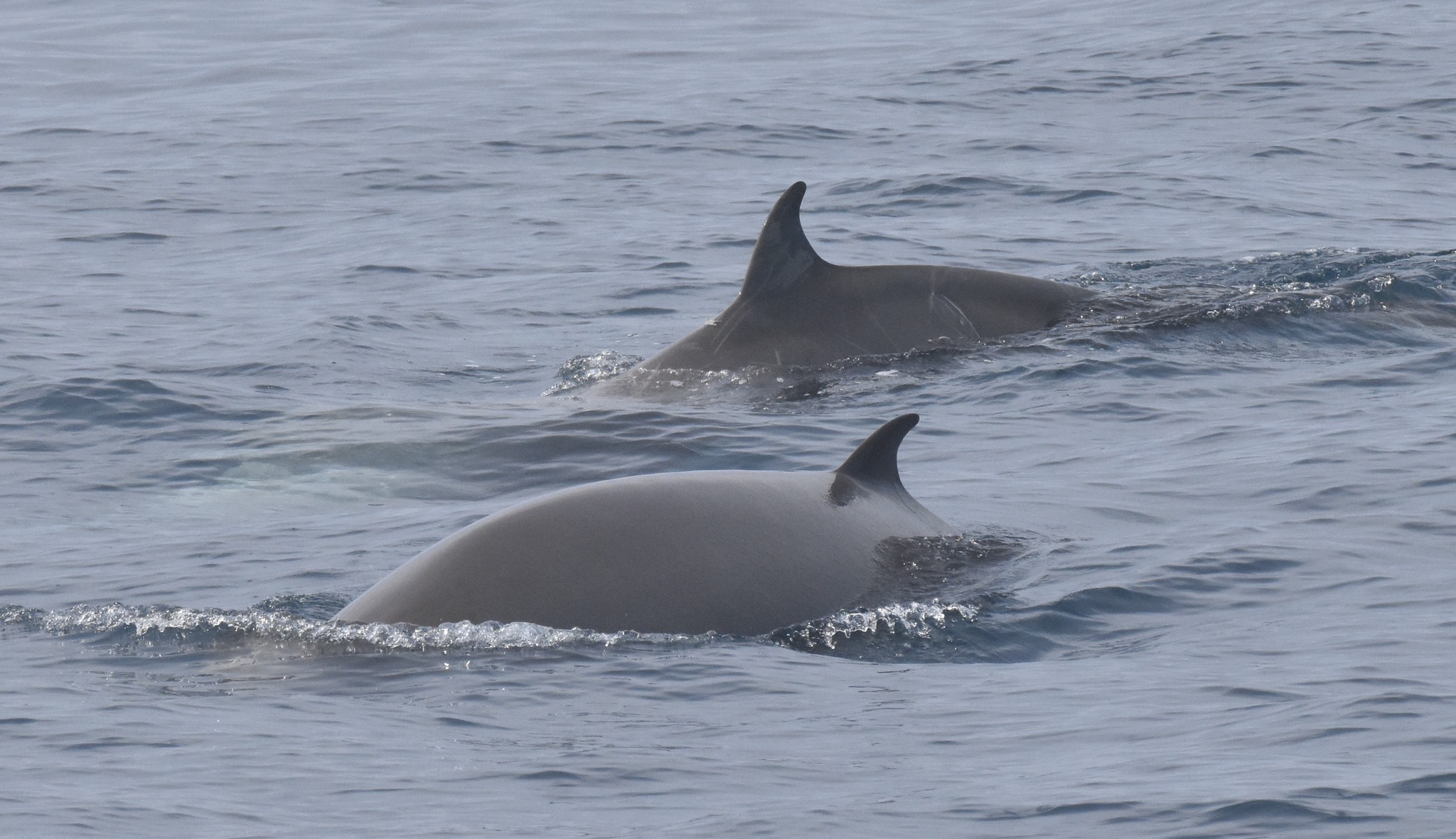
Cuvier’s beaked whales off Cape May, New Jersey in June 2022. Image credit: CMWWRC Database/Melissa Laurino
In addition, marine mammal blood is rich in myoglobin, which binds strongly to oxygen (Fontaine, 2007) During the dive, marine mammals redistribute the flow of the oxygen-rich blood through their bodies to prioritize organs that need oxygen the most (such as the brain and spinal cord), and decrease their heart rate to conserve energy and oxygen during a dive (Fontaine, 2007). When a whale encounters the pressure of deep depths, the body of the animal does not rigidly resist this pressure like a hard shell. Instead, the whales are adapted to naturally compress at these depths. This includes the lungs, as well as the airways (Moore et al. 2011; Denk et al. 2020).
Sowerby’s beaked whale surfacing near a mylar balloon during the observation on American Star. Mylar and plastic in the water represent one of the threats faced by beaked whales, as these objects may be accidentally consumed. Plastic bags have been documented to cause digestive tract obstructions in beaked whales.
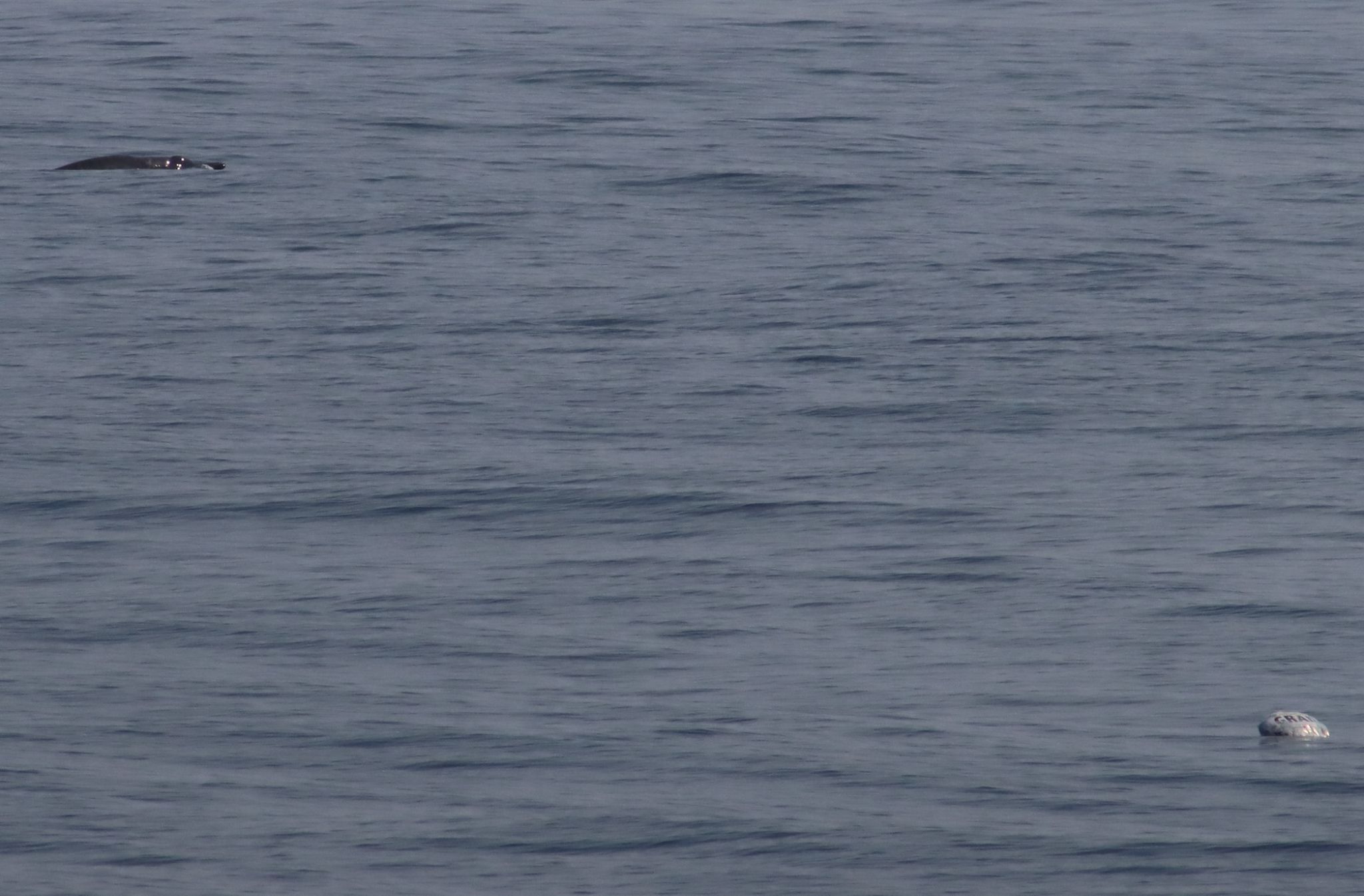
The elusive Sowerby’s beaked whale surfaces near a mylar balloon. Image credit: CMWWRC database – Clean Ocean Initiative
The passengers and crew were extremely fortunate to see a Sowerby’s beaked whale mother and calf during the 24 hour pelagic trip. For many, this was an unforgettable first-time experience with this species. The thrill of observing beaked whales lies within the fact that they are air-breathing mammals like us, and yet they spend their entire life out of the sight of land in the open ocean. However, much work remains to be performed to study these animals. Since beaked whales are deep divers that live in the open ocean and spend relatively little time at the surface, they are some of the most poorly studied of all large mammals.
Beaked whales are so little known that even many basic aspects of population dynamics, anatomy, physiology, and the illnesses that may affect them are unknown. It is therefore very important for us to continue studying all aspects of these rare animals and their behavior in the future. Only by better knowing these rare animals can we assess the means to better understand and protect them.

Cuvier’s beaked whales surfacing in the rising sun. Image credit: CMWWRC database/Michael Denk
